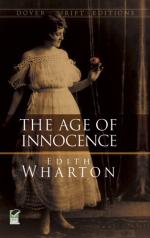Her visitors were startled and fascinated by the foreignness of this arrangement, which recalled scenes in French fiction, and architectural incentives to immorality such as the simple American had never dreamed of. That was how women with lovers lived in the wicked old societies, in apartments with all the rooms on one floor, and all the indecent propinquities that their novels described. It amused Newland Archer (who had secretly situated the love-scenes of “Monsieur de Camors” in Mrs. Mingott’s bedroom) to picture her blameless life led in the stage-setting of adultery; but he said to himself, with considerable admiration, that if a lover had been what she wanted, the intrepid woman would have had him too.
To the general relief the Countess Olenska was not present in her grandmother’s drawing-room during the visit of the betrothed couple. Mrs. Mingott said she had gone out; which, on a day of such glaring sunlight, and at the “shopping hour,” seemed in itself an indelicate thing for a compromised woman to do. But at any rate it spared them the embarrassment of her presence, and the faint shadow that her unhappy past might seem to shed on their radiant future. The visit went off successfully, as was to have been expected. Old Mrs. Mingott was delighted with the engagement, which, being long foreseen by watchful relatives, had been carefully passed upon in family council; and the engagement ring, a large thick sapphire set in invisible claws, met with her unqualified admiration.
“It’s the new setting: of course it shows the stone beautifully, but it looks a little bare to old-fashioned eyes,” Mrs. Welland had explained, with a conciliatory side-glance at her future son-in-law.
“Old-fashioned eyes? I hope you don’t mean mine, my dear? I like all the novelties,” said the ancestress, lifting the stone to her small bright orbs, which no glasses had ever disfigured. “Very handsome,” she added, returning the jewel; “very liberal. In my time a cameo set in pearls was thought sufficient. But it’s the hand that sets off the ring, isn’t it, my dear Mr. Archer?” and she waved one of her tiny hands, with small pointed nails and rolls of aged fat encircling the wrist like ivory bracelets. “Mine was modelled in Rome by the great Ferrigiani. You should have May’s done: no doubt he’ll have it done, my child. Her hand is large—it’s these modern sports that spread the joints—but the skin is white.—And when’s the wedding to be?” she broke off, fixing her eyes on Archer’s face.
“Oh—” Mrs. Welland murmured, while the young man, smiling at his betrothed, replied: “As soon as ever it can, if only you’ll back me up, Mrs. Mingott.”
“We must give them time to get to know each other a little better, mamma,” Mrs. Welland interposed, with the proper affectation of reluctance; to which the ancestress rejoined: “Know each other? Fiddlesticks! Everybody in New York has always known everybody. Let the young man have his way, my dear; don’t wait till the bubble’s off the wine. Marry them before Lent; I may catch pneumonia any winter now, and I want to give the wedding-breakfast.”




